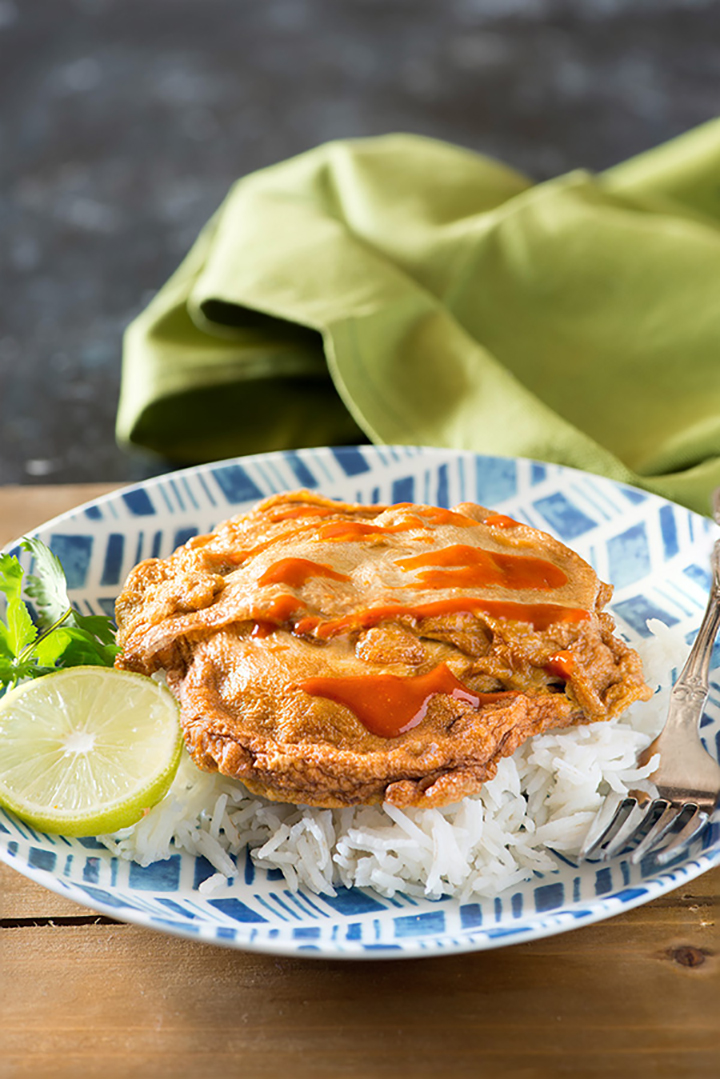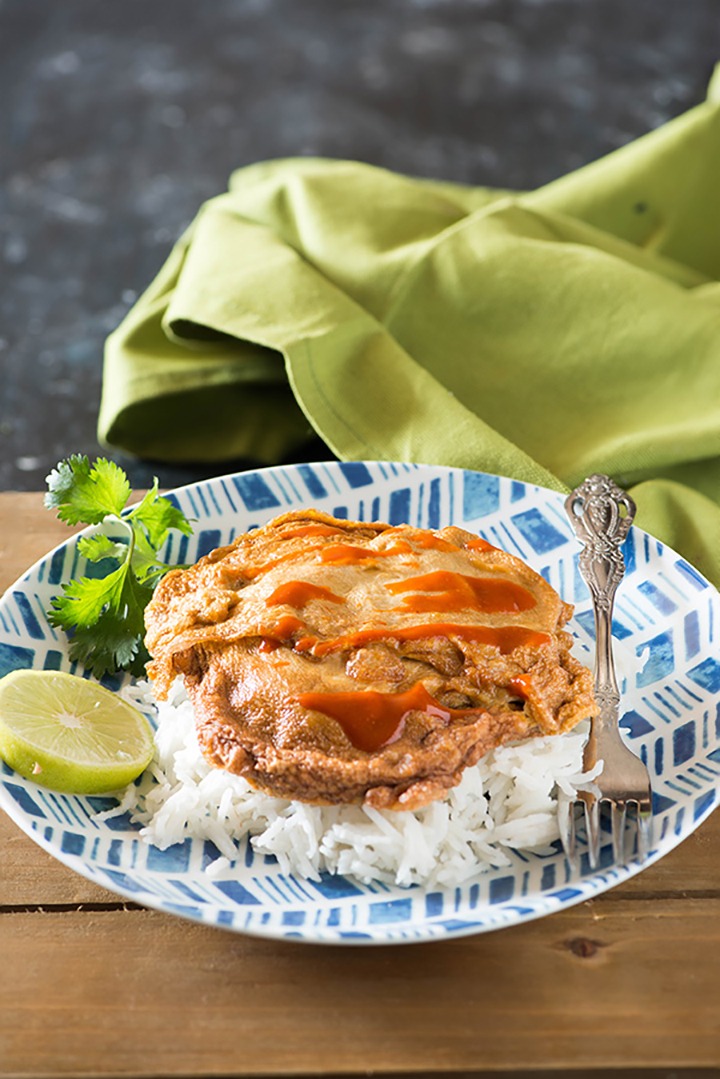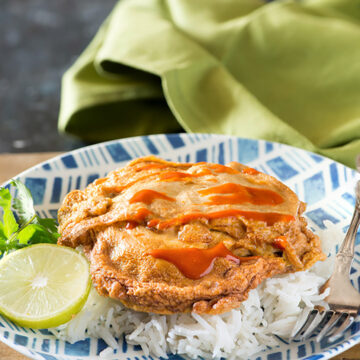When it comes to Thai cuisine, the humble Thai omelette, or Kai Jeow, holds a special place. This traditional Thai omelette is not just a dish; it’s a testament to the simplicity and flavor that characterizes Thai street food. Whether you’re looking for a quick breakfast or a light meal, this Thai egg omelette is your go-to recipe. In this blog post, I am sharing easy Thai omelette recipe, its ingredients and variations, along with best tips for making it at home, wherever you are in the world. Thai omelette is a golden and crisp omelet that is often served as a rice topper in Thailand. Unlike most varieties of omelette, this one is not a breakfast dish, it is served mostly with rice or any sour and spicy dish as a main meal. For making a Thai omelette you need very few ingredients and it is very easy to make. This requires a special technique that is slightly different from the regular omelette of any kind.
Ingredients for Thai Omelette
What is Kai Jeow?
Kai Jeow, pronounced “Khai Jiao,” is a classic Thai dish known for its crispy edges and fluffy interior. It’s a staple in Thai street food culture, often enjoyed as a quick, delicious meal. This Thai street food omelette can be found sizzling in woks throughout Thailand, offering a delightful combination of texture and taste.
How to Make Thai Omelette at Home
Making a Thai omelette at home is simple and rewarding. Here’s a step-by-step Kai jeow recipe that captures the authentic flavors of Thailand.
Ingredients:
2 large eggs 1 tablespoon fish sauce (or soy sauce for a vegetarian Thai omelette) 1 tablespoon lime juice 1 teaspoon sugar 1 cup of cooking oil (for deep frying) Optional: chopped herbs, sliced chilies, or minced pork
Instructions:
Tips for a Perfect Thai Omelette
Cooking Techniques: The best way to cook Thai omelette is with plenty of hot oil, which ensures the outer layer becomes crispy while the inside remains soft. Thai Omelette Frying Techniques: Use a high smoke point oil like vegetable or sunflower oil for deep frying. This helps achieve the perfect texture without burning. Crispy Thai Omelette: To make a truly crispy omelette, make sure the oil is hot enough to bubble vigorously when the egg mixture is added.
Variations and Dietary Options
The beauty of Kai Jeow lies in its versatility. Here are some variations to suit different tastes and dietary preferences:
Vegetarian Thai Omelette: Substitute fish sauce with soy sauce and add vegetables like tomatoes, onions, or mushrooms for a delicious vegetarian Thai omelette recipe. Keto Thai Omelette Recipe: Skip the sugar and serve the omelette with low-carb sides like avocado or a green salad. Paleo Thai Omelette Recipe: Use coconut aminos instead of fish sauce and serve with a variety of vegetables. Vegan Thai Omelette Alternatives: Use chickpea flour and water as an egg substitute, and enhance the flavor with a pinch of black salt for an eggy taste.
Serving Suggestions
Wondering what to serve with Thai omelette? Here are some ideas:
Thai Omelette and Rice Combinations: Serve with jasmine rice or sticky rice to complement the omelette’s texture and flavor. Thai Omelette Side Dishes: Pair with a light cucumber salad, pickled vegetables, or a tangy dipping sauce like sriracha.
Regional and Cultural Significance
Kai Jeow is more than just a dish; it’s a cultural symbol found in every corner of Thailand. From the bustling streets of Bangkok to the serene countryside, this traditional Thai omelette is a common sight, reflecting the diverse flavors of Thai cuisine.
Health and Nutrition
For those looking for a healthy Thai omelette option, consider the following:
Low-Calorie Thai Omelette: Use minimal oil and add plenty of vegetables for a nutritious meal. Spicy Thai Omelette Recipe: Add fresh chilies to the mix for a metabolism-boosting kick. Thai Omelette Without Fish Sauce: Ideal for those with dietary restrictions or preferences, using alternatives like soy sauce.
Tips for Making good Thai Omelette
I add little corn flour while making the omelette to make it crispier. Main thing while making this deep-fried omelette is you need either a wok or kadhai. The reason being, we need lesser surface area for the batter to remain concentrated. Otherwise, it may fall flat while cooking and may not turn out crispy as it should be. While pouring batter into the wok, make sure to pour it from the height as it helps in forming crispy edges of the omelet. Oil should be smoking hot before you pour the omelet batter into the wok.
Watch How to Make Thai Omelet - Kai Jiew
More Such Recipes
Indian Masala Omelette Curry Spinach Omelette Eggless Omelette Ultimate Baked Omelette Stuffed in Toast Thai Cucumber Salad Thai Peanut Noodles Recipe Thai Red Curry Noodles
If You like this recipe and made it Please rate the recipe. It helps us to reach more people. For the Latest updates Subscribe to Rekha’s Whatsapp. You can follow me on Instagram, Facebook, Youtube, Pinterest for more food inspirations.
📖 Recipe


